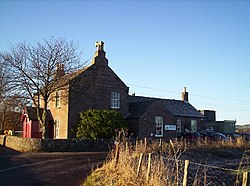Stracathro
| Stracathro | |
| Angus | |
|---|---|
 Stracathro School | |
| Location | |
| Grid reference: | NO619648 |
| Location: | 56°46’24"N, 2°37’30"W |
| Data | |
| Post town: | Brechin |
| Postcode: | DD9 |
| Dialling code: | 01356 |
| Local Government | |
| Council: | Angus |
| Parliamentary constituency: |
Angus |
Stracathro is a small place in Angus; not so much a village as an area of hamlets and farmsteads, of which the most central is Westerton of Stracarro. Its name is from the Gaelic Srath Catharach, in reference to the broad valley of the River South Esk.
Stracathro is to be found at the very edge of the county, on the west side of the River South Esk, which here marks the boundary with Kincardineshire. Here the South Esk is joined, on the Angus bank, by the West Water and the little Cuick Water.
The locale is two and a half miles southeast of Edzell the northeast of the county. It lies to the northeast of Brechin on the A90. The Hill of Stracarro rises to the south of the A90.
History
The remains of a Roman marching camp have been discovered at Stracathro. This Roman Camp is one day's march from the next camp, at Raedykes to the north.[1] The gate design of the Stracathro Roman Camp is a distinctive bell-shaped indentation of the rampart perimeter.[2]
At Stracathro on 7 July 1296, John Balliol King of Scots publicly confessed the error of his rebellion against King Edward I of England, and confirmed his reconciliation with Edward.
Stracathro House

Stracathro House is a fine A-listed Palladian-style mansion, overlooking the Cruick Water.
In 1775, the Stracathro Estate, which extended to almost 1,980 acres, was bought by Patrick Cruickshank who had made his fortune in Jamaica.[3] His brother, Alexander inherited the property and employed the Aberdeen-based architect Archibald Simpson (1790–1847) to build the house between 1824–27, together with a deer-park and gardens. In 1874, the house and estate was purchased by Sir James Campbell (1790–1876), Lord Provost of Glasgow and father of Prime Minister Sir Henry Campbell-Bannerman (1836–1908).[3]
Stracathro House reverted to private ownership following its sale by NHS Tayside in 2003. It is being refurbished as a family home.[3] Cottages in the grounds are let as self-catering holiday accommodation.[4]
Stracathro Hospital
Stracathro House was leased by the government in 1938 and a temporary Emergency Medical Services Hospital built in the grounds to cope with military and civilian casualties of Second World War.[3] The house was used as a residence for doctors and nurses and was later purchased by the local health authority. Stracathro Hospital became a District General Hospital and is now part of NHS Tayside
References
- ↑ C. Michael Hogan (3 October 2007). "Raedykes Roman Camp". in Andy Burnham. The Megalithic Portal. http://www.megalithic.co.uk/article.php?sid=17674. Retrieved 2009-08-29.
- ↑ "Stracathro Roman Camp". Roman Britain. 2005. http://www.roman-britain.org/places/stracathro_camp.htm. Retrieved 2009-08-29.
- ↑ 3.0 3.1 3.2 3.3 "Stracathro House". Gazetteer for Scotland. http://www.scottish-places.info/features/featurefirst10189.html. Retrieved 2009-08-29.
- ↑ "Stracathro Holiday Cottages". franclyn ltd. http://www.stracathro-holidaycottages.co.uk/. Retrieved 2010-01-31.